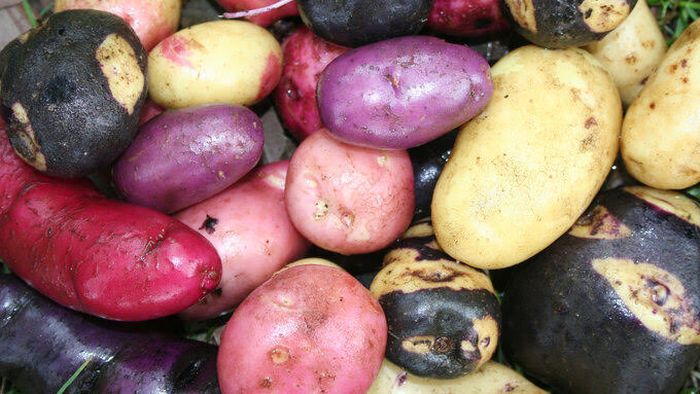FAO Feature: On the International Day of Potato, Agriculture Post brings a special FAO Feature on the potato’s travel through ages and continents.
The potato has a rich history that began around 8,000 years ago in the Andes of South America. Early hunter-gatherer communities around Lake Titicaca domesticated wild potato plants. In the 16th century, the Spanish brought the potato to Europe from Peru, cultivating it in Spain before distributing it across Europe as exotic gifts to botanists and prominent figures like the Pope.
Sailors quickly appreciated the potato for its nutritional value during long voyages, facilitating its spread worldwide and leading to large-scale cultivation. Today, the potato ranks as the third most consumed food globally, largely due to its efficiency in producing a high yield on minimal land.
For many years, Europe relied on a limited number of potato varieties despite the existence of many more. This lack of genetic diversity made European potatoes highly susceptible to diseases. A notable example is the late blight disease that devastated Ireland’s potato crops, causing the Great Famine of the 1840s.
You may also like to read – Nuclear technologies offer unique tools to set science-based global food safety standards: FAO
In recognition of its importance, the United Nations has designated May 30 as International Day of the Potato. The Food and Agriculture Organization of the United Nations (FAO) prioritises preserving the diversity of potato crops to ensure they remain a cornerstone of sustainable agriculture and food security. Supporting this effort is the FAO’s Globally Important Agricultural Heritage System (GIAHS) programme, which protects the invaluable traditions of farmers and sustainable agrifood systems that maintain local, biodiverse varieties of essential crops like potatoes.
Here are four innovative GIAHS starring potatoes
Chiloé, Chile: the birthplace of commercial potatoes
Essential to the preservation of potato biodiversity is the Archipelago of Chiloé, a GIAHS site in Chile. Recent DNA evidence reveals that many potato varieties grown worldwide are closely related to those from Chile.
Before agricultural modernisation, the Indigenous communities of Chiloé cultivated between 800 and 1,000 native potato varieties. However, the emergence of diseases and the spread of commercial seeds have reduced this number to 91 varieties. Rural women play a crucial role in preserving this genetic diversity, actively engaging in conservation efforts on their farms.
Today, potatoes are the primary crop cultivated on the remote islands of Chiloé, serving as a vital component of local livelihoods. The value of Chiloé’s potatoes extends far beyond the archipelago, significantly contributing to global food security.
The thousands of varieties in the Andes, Peru
In another GIAHS site in the Andes, potato crops cultivated on the hills are a vital source of nutrition for local populations. These crops are grown using traditional knowledge and sustainable practices passed down by farmers and Indigenous communities. As a result, over 4,000 species of potatoes, including wild varieties, thrive in the Andean region.
You may also like to read – Agrishow 2024: BMS project generates US$49 Mn in business; strengthens image of Brazilian agri machinery industry
Andean agriculture exemplifies farmers’ adaptation to their environment, mastering the domestication of endemic potato species and cultivating them at altitudes of 3,300 to 3,800 meters. These native crops are primarily consumed locally. Dehydrated potatoes, known as chuño, are preserved for years and serve as a crucial food source during dry periods.
However, the migration of youth to cities is leading to a significant loss of knowledge and biodiversity. Despite this challenge, the cultural norms and rituals of local Indigenous communities help maintain the agricultural identity of the region, preserving thousands of potato varieties.
Grown out of sand in Ramli, Tunisia
In Ghar El Melh, a GIAHS site in Tunisia, farmers employ a unique technique called Ramli, which involves growing crops on sand. These crops are cultivated in sandy beds irrigated by freshwater from tidal movements. This delicate system relies on generational knowledge to prevent the crops from being inundated by saltwater, which would be fatal.
You may also like to read: TMG enhances genetic improvement efficiency with advanced traceability and phenotyping technology
In the lagoons of Ghar El Melh, potatoes are a crucial component of local food production and a vital source of livelihood due to high market demand.
The White Gold of Barroso, Portugal
The mild climate of the Barroso region in Portugal, another GIAHS site, makes it ideal for potato cultivation. Potatoes, referred to as the region’s ‘white gold,’ have become the most valuable crop for farmers. This thriving production has improved living conditions for local families, enabling them to afford better clothing and upgrade their homes.
Since the 18th century, experts have lauded the renowned potatoes from ‘Tras-os-Montes,’ highlighting their socio-cultural importance and long-standing history. The crop’s reputation and value have earned it the Protected Geographical Indication certification, which attests to the quality of a product tied to its geographical origin.
The potato has traversed a long journey through time and geography, now contributing significantly to global food security and livelihoods. Celebrate the International Day of the Potato, by exploring local potato varieties, discovering new cooking methods, and sharing your newfound appreciation for this ubiquitous tuber with friends.
Photo Credit: FAO/ International Day of Potato




